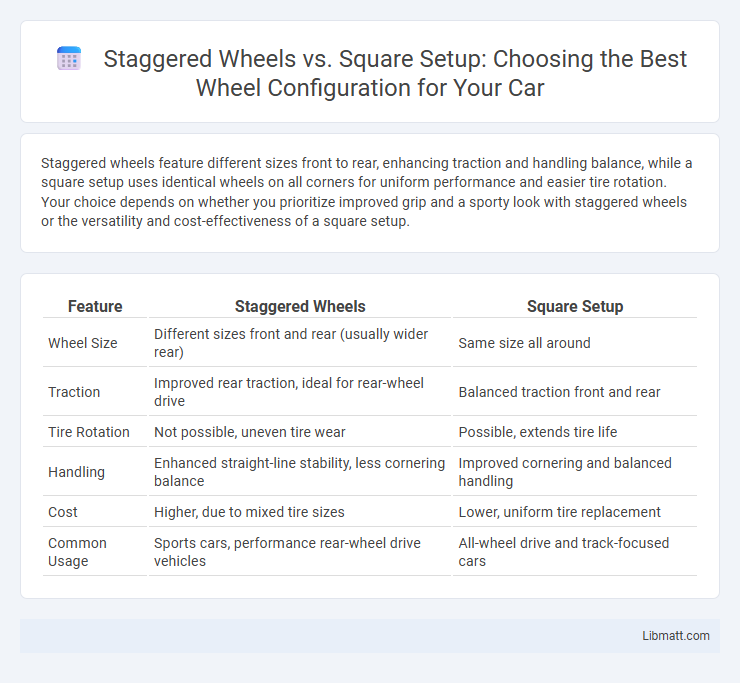Staggered wheels feature different sizes front to rear, enhancing traction and handling balance, while a square setup uses identical wheels on all corners for uniform performance and easier tire rotation. Your choice depends on whether you prioritize improved grip and a sporty look with staggered wheels or the versatility and cost-effectiveness of a square setup.
Table of Comparison
| Feature | Staggered Wheels | Square Setup |
|---|---|---|
| Wheel Size | Different sizes front and rear (usually wider rear) | Same size all around |
| Traction | Improved rear traction, ideal for rear-wheel drive | Balanced traction front and rear |
| Tire Rotation | Not possible, uneven tire wear | Possible, extends tire life |
| Handling | Enhanced straight-line stability, less cornering balance | Improved cornering and balanced handling |
| Cost | Higher, due to mixed tire sizes | Lower, uniform tire replacement |
| Common Usage | Sports cars, performance rear-wheel drive vehicles | All-wheel drive and track-focused cars |
What Are Staggered Wheels?
Staggered wheels feature different sizes for the front and rear wheels, typically with wider tires at the rear to enhance traction and stability during cornering. This setup improves your vehicle's handling dynamics by optimizing grip and balance, especially in performance and sports cars. Unlike square setups, where all four wheels and tires are identical, staggered wheels prioritize rear traction but may require tire rotation considerations.
What Is a Square Wheel Setup?
A square wheel setup refers to a vehicle configuration where all four wheels are the same size, promoting balanced handling and uniform tire wear. This setup enhances steering precision and stability, especially in performance driving or track conditions. Your vehicle benefits from improved grip and consistent performance across all corners compared to staggered wheels, which use different sizes front and rear.
Key Differences Between Staggered and Square Setups
Staggered setups feature different wheel sizes on the front and rear axles, typically wider wheels at the rear for enhanced traction and aggressive stance, commonly used in performance cars and rear-wheel drive vehicles. Square setups use identical wheel sizes on all four corners, promoting even tire wear, simplified rotation, and improved predictability in handling. Choosing between staggered and square setups depends on factors such as drivetrain configuration, performance goals, and maintenance preferences.
Performance Impacts: Staggered vs Square Wheels
Staggered wheels, with larger rear tires and narrower front tires, enhance traction and stability during acceleration, making them ideal for rear-wheel-drive sports cars seeking improved cornering grip. Square wheel setups use identical tire sizes on all corners, promoting balanced handling characteristics and simplified tire rotation, which extends tire life and maintains consistent performance. Your choice between staggered and square setups directly affects vehicle dynamics, including traction, tire wear, and handling balance.
Handling and Traction Considerations
Staggered wheels, featuring wider rear tires and narrower fronts, enhance traction and stability during acceleration by increasing rear contact patch size, crucial for rear-wheel-drive vehicles. A square setup, with equal tire and wheel sizes on all corners, provides balanced handling and more predictable grip, improving cornering precision and tire rotation options. Drivers prioritizing aggressive acceleration and rear grip benefit from staggered setups, while those seeking even handling dynamics and tire longevity prefer the square configuration.
Aesthetic Appeal: Visual Differences
Staggered wheels, featuring larger and wider wheels on the rear axle, offer a more aggressive and sporty aesthetic compared to the uniform look of a square setup, where all four wheels match in size. This rear-biased stance accentuates vehicle width and enhances visual dynamics, often preferred in performance and luxury cars. The square setup provides a balanced and symmetrical appearance that appeals to purists seeking uniformity and simplicity in wheel design.
Tire Rotation and Maintenance
Staggered wheel setups limit tire rotation options since front and rear tires differ in size, leading to uneven tire wear and increased maintenance costs. Square setups use identical wheels and tires on all corners, enabling regular tire rotations that promote even wear and extend tire lifespan. Proper tire rotation in square setups improves performance consistency and reduces overall tire replacement frequency compared to staggered configurations.
Vehicle Compatibility and Fitment
Staggered wheels, with wider rear tires and narrower fronts, suit rear-wheel-drive vehicles and enhance traction during acceleration, providing optimal fitment for sports cars and performance sedans. Square setups use identical tire sizes on all four corners, offering easier tire rotation, improved balanced handling, and compatibility with all-wheel-drive vehicles. Your choice depends on your vehicle's drivetrain and specific performance goals to ensure proper fitment and maximum driving efficiency.
Cost Comparison: Staggered vs Square
Staggered wheel setups, featuring wider rear wheels, typically cost more due to the need for different sizes and often require separate tires and rims, increasing overall expenses. Square setups use identical wheel and tire sizes front and rear, reducing replacement and maintenance costs while improving rotational flexibility. Maintenance and tire rotation options contribute to the square setup's cost efficiency compared to the staggered setup's higher upfront and ongoing expenses.
Which Setup Is Right for You?
Choosing between staggered wheels and a square setup depends on your driving style and vehicle purpose. Staggered wheels, with wider rear tires, enhance traction and cornering performance, ideal for sports cars focused on high-speed stability. Square setups, featuring equal tire sizes on all corners, provide uniform tire wear and simpler rotation, making them suited for daily drivers and track enthusiasts seeking balanced handling and tire longevity.
staggered wheels vs square setup Infographic

 libmatt.com
libmatt.com